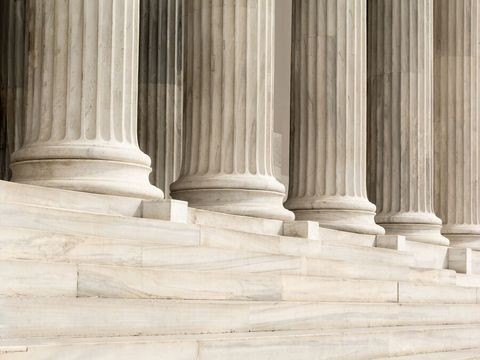Supreme Court Upholds Conviction of Government Contractor Under Federal Wire Fraud Law Despite Lack of Economic Harm
What You Need to Know
Key takeaway #1
In Kousisis et al. v. United States, the Supreme Court of the United Sates upheld the fraudulent inducement theory of liability under the federal wire fraud statute, regardless of whether the victim suffered any economic loss.
Key takeaway #2
Going forward, these fraudulent inducement cases will depend heavily on the materiality requirement, asking whether the misrepresentation was significant enough to affect the procurement decision.
Key takeaway #3
There have been a growing number of government enforcement actions in cases where a government contractor is alleged to have fraudulently induced an award that was set aside for a certain socio-economic group. Following the Court’s ruling in Kousisis, the wire fraud statute remains a viable option for DOJ in criminal investigations.
Client Alert | 5 min read | 05.28.25
The Supreme Court last week blessed a broad reading of the federal wire fraud statute, resolving a circuit split over whether economic loss is an element of fraudulent inducement and bolstering the Government’s future enforcement of procurement fraud. In Kousisis et al. v. United States (unanimous in judgment), the Court upheld the conviction of a government contractor for falsely representing compliance with disadvantaged business enterprise (DBE) requirements in contracts awarded by the Pennsylvania Department of Transportation (PennDOT), despite completing the contracts to PennDOT’s satisfaction. The Court held that a material misrepresentation used to deceive someone into parting with money or property is sufficient for a federal wire fraud conviction, regardless of whether the victim suffered any economic loss.
This holding marks a departure from recent cases that have narrowly interpreted the wire fraud statute, limiting its use by federal prosecutors. See Ciminelli v. United States (holding that the right-to-control theory cannot support a wire fraud conviction); Kelly v. United States (holding that reconfiguring bridge lanes was not considered a taking of money or property under the wire fraud statute). The decision comes on the heels of the Department of Justice’s Criminal Division’s addition of criminal federal procurement and government program fraud as a priority category for the Corporate Whistleblower Awards Pilot Program.
The Kousisis Decision
Stamatios Kousisis helped manage Alpha Painting and Construction Co., an industrial-painting company that received two government contracts from PennDOT, requiring participation of a disadvantaged business. Alpha misrepresented that it would obtain its materials from Markias, Inc., a pre-qualified disadvantaged business, but in fact used them purely as a pass-through entity for Alpha’s actual paint suppliers. Markias would receive an invoice from the actual supplier, mark it up, and forward it to Kousisis. In other words, “Markias was no more than a paper pusher.” Notably, PennDOT was satisfied with the work and paid accordingly.
Kousisis and Alpha were convicted of wire fraud and conspiracy to commit the same under 18 U.S.C., §§ 1343 & 1349. The Third Circuit affirmed their convictions. Under the wire fraud statute, the Government has the burden to prove that defendants used the wires to execute a “scheme or artifice to defraud, or for obtaining money or property by means of false or fraudulent pretenses, representations, or promises.” 18 U.S.C. § 1343. Kousisis and Alpha argued that the Government could not prove that they had schemed to defraud PennDOT of “money or property” because PennDOT had received the “full economic benefit of its bargain”—i.e., there was no economic loss to PennDOT.
The Court disagreed. It held that “[a] defendant who induces a victim to enter into a transaction under materially false pretenses may be convicted of federal fraud even if the defendant did not seek to cause the victim economic loss.” As parsed by the Court, the wire fraud statute requires the Government to prove that a defendant—
- Devised or intended to devise a scheme
- To obtain money or property
- By means of materially false or fraudulent pretenses, representations, or promises.
In short, the wire fraud statute does not mention, much less require, actual economic loss. Applied here, Kousisis and Alpha devised a scheme to “feign” compliance with PennDOT’s disadvantaged-business requirements with the goal of obtaining money from PennDOT by making false or fraudulent representations. According to the Court, the wire fraud statute requires nothing more.
The Court rejected arguments that economic loss was inherent to the common-law understanding of fraud, that the holding was inconsistent with its precedent, and that the holding risks turning every misrepresentation into fraud.
Going forward, these cases will depend heavily on the materiality requirement, asking whether the misrepresentation was important to the procurement decision.
Civil False Claims Act Implications
While this decision hinges on the terms of the wire fraud statute, the same bottom-line rule applies in the civil False Claims Act (FCA) context: The Government need not suffer economic harm to prove FCA liability, and courts have held that damages are not an element of FCA liability. Whether there are any damages, and how to measure them, is a different question entirely.
The dueling concurrence opinions on materiality are also noteworthy from an FCA perspective because the Court appears to view materiality the same in criminal and civil contexts, as the Court’s reliance on Universal Health Services, Inc. v. United States ex rel. Escobar, a civil FCA case, makes clear. As established in Escobar, the materiality standard in the FCA context is demanding and “[a] misrepresentation cannot be deemed material merely because the Government designates compliance with a particular statutory, regulatory, or contractual requirement as a condition of payment.” In his concurrence in Kousisis, Justice Thomas, who also authored the Escobar opinion, set the materiality bar high and argued as a practical matter that compliance with the DBE requirement was not really material. Justice Sotomayer, in her concurrence in Kousisis, went in the opposite direction, arguing that materiality was “hard to dispute, even under the Government’s more demanding standard.” While this is all dicta because Kousisis and Alpha conceded materiality, it is notable that the Court invoked Escobar in its articulation of the materiality standard in this wire-fraud case, applying Escobar beyond the FCA context. It could mean that the Court’s holdings on materiality in other contexts likewise have implications for FCA cases, as they are rooted in principles of common-law fraud.
Implications
In recent years, there have been a growing number of civil and criminal enforcement actions in cases where a government contractor is alleged to have fraudulently induced an award that was set aside for a certain socio-economic group. According to the DOJ and the whistleblowers bringing these suits, this type of fraud impedes the government’s socio-economic policy goals even where goods or services were otherwise delivered according to contract specification. Indeed, this issue arises in a variety of alleged fraudulent schemes that result in no harm to the government or an allegation of harm that is largely or entirely intangible.
Following the Court’s ruling in Kousisis, the wire fraud statute will remain an arrow in the DOJ’s quiver at a time when procurement fraud is in the Government’s crosshairs. Prior to the start of the second Trump Administration, more than $100B flowed to transportation infrastructure projects under the Infrastructure Investment and Jobs Act (IIJA), of which 10% was supposed to be awarded to DBEs. This combination of significant federal dollars and the Criminal Division’s focus on procurement fraud portend more prosecutions of set-aside fraud in the years ahead.
Contacts
Insights
Client Alert | 5 min read | 12.12.25
Eleventh Circuit Hears Argument on False Claims Act Qui Tam Constitutionality
On the morning of December 12, 2025, the Eleventh Circuit heard argument in United States ex rel. Zafirov v. Florida Medical Associates, LLC, et al., No. 24-13581 (11th Cir. 2025). This case concerns the constitutionality of the False Claims Act (FCA) qui tam provisions and a groundbreaking September 2024 opinion in which the United States District Court for the Middle District of Florida held that the FCA’s qui tam provisions were unconstitutional under Article II. See United States ex rel. Zafirov v. Fla. Med. Assocs., LLC, 751 F. Supp. 3d 1293 (M.D. Fla. 2024). That decision, penned by District Judge Kathryn Kimball Mizelle, was the first success story for a legal theory that has been gaining steam ever since Justices Thomas, Barrett, and Kavanaugh indicated they would be willing to consider arguments about the constitutionality of the qui tam provisions in U.S. ex rel. Polansky v. Exec. Health Res., 599 U.S. 419 (2023). In her opinion, Judge Mizelle held (1) qui tam relators are officers of the U.S. who must be appointed under the Appointments Clause; and (2) historical practice treating qui tam and similar relators as less than “officers” for constitutional purposes was not enough to save the qui tam provisions from the fundamental Article II infirmity the court identified. That ruling was appealed and, after full briefing, including by the government and a bevy of amici, the litigants stepped up to the plate this morning for oral argument.
Client Alert | 8 min read | 12.11.25
Director Squires Revamps the Workings of the U.S. Patent Office
Client Alert | 8 min read | 12.10.25
Creativity You Can Use: CJEU Clarifies Copyright for Applied Art
Client Alert | 4 min read | 12.10.25
Federal Court Strikes Down Interior Order Suspending Wind Energy Development











